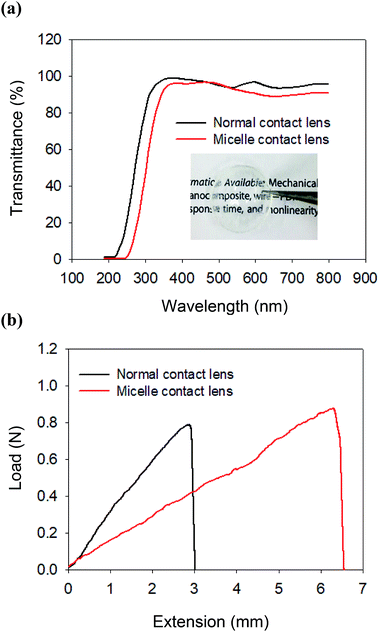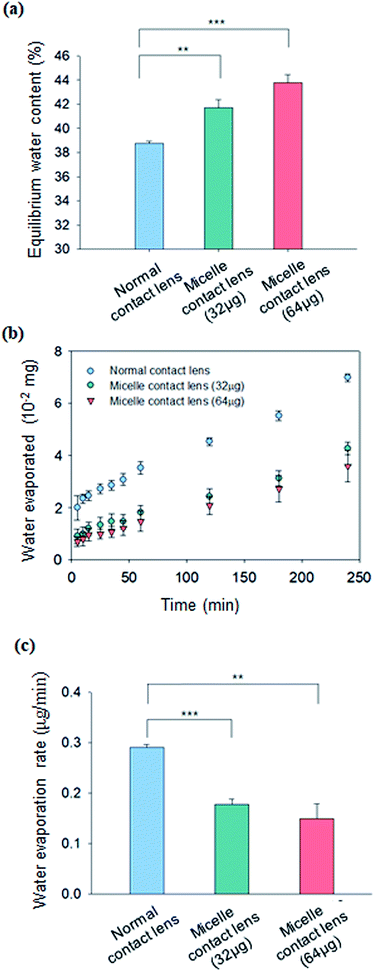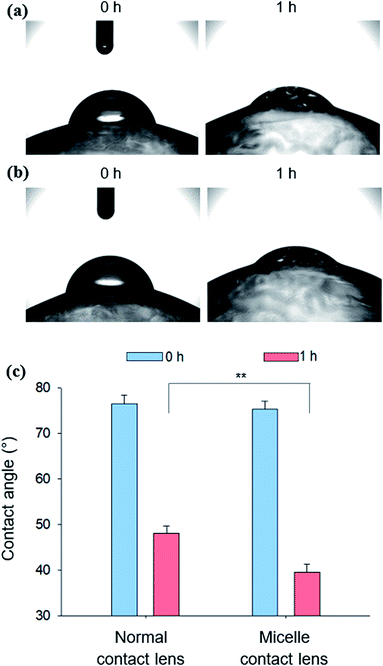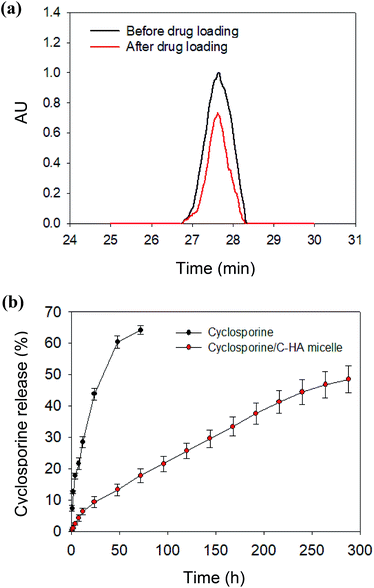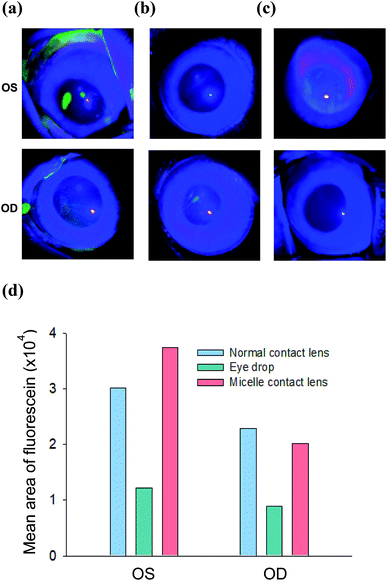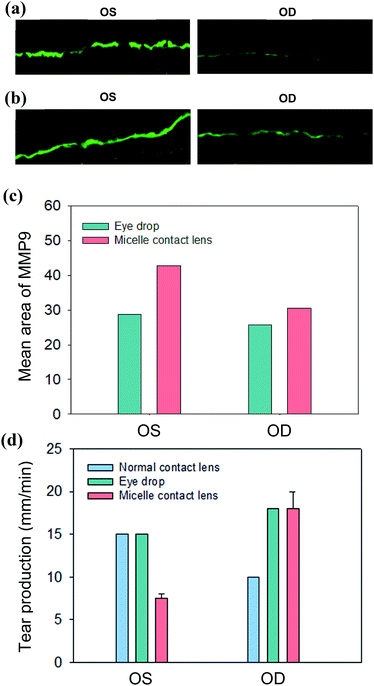 Open Access Article
Open Access ArticleCreative Commons Attribution 3.0 Unported Licence
Drug-eluting contact lens containing cyclosporine-loaded cholesterol-hyaluronate micelles for dry eye syndrome†
Jonghwan
Mun‡
a,
Jee won
Mok‡
b,
Sanghoon
Jeong
a,
Seonghwi
Cho
a,
Choun-Ki
Joo
*b and
Sei Kwang
Hahn
 *a
*a
aDepartment of Materials Science and Engineering, Pohang University of Science and Technology (POSTECH), 77 Cheongam-ro, Nam-gu, Pohang, Gyeongbuk 37673, Korea. E-mail: skhanb@postech.ac.kr; Fax: +82 54 279 2399; Tel: +82 54 279 2159
bDepartment of Ophthalmology and Visual Science, Seoul St. Mary's Hospital, Collage of Medicine, The Catholic University of Korea, 505, Banpo-dong, Seocho-gu, Seoul 06591, Korea. E-mail: ckjoo@catholic.ac.kr; Fax: +82 2 533 3801; Tel: +82 2 2258 1173
First published on 28th May 2019
Abstract
A contact lens is an attractive tool for the delivery of ophthalmic drugs, but it has several issues such as the burst release of drugs and the limited drug loading capacity. To overcome these limitations, we developed a cholesterol-hyaluronate (C-HA) micelle-embedded contact lens for efficient hydrophobic drug loading and long-term controlled drug delivery. The contact lens was fabricated via photopolymerization of hydroxyethyl methacrylate (HEMA) using ethylene glycol dimethacrylate (EGDMA) as a cross-linker. The C-HA micelle-loaded contact lens showed statistically significant improvement in wettability and mechanical strength, maintaining the optical transmittance. In vitro drug release tests revealed the controlled delivery of cyclosporine for more than 12 days. Furthermore, the Schirmer tear test, corneal fluorescein staining, and MMP9 fluorescein analysis confirmed its therapeutic effect on dry eye syndrome in disease model rabbits.
1. Introduction
Eye diseases are commonly treated by periodic eye drops of relevant drugs due to patient compliance. In this case, however, the drug delivery efficiency is reported to be less than 1% with significant drug loss.1,2 In addition, the residence time of drugs delivered by eye drops is in the range of 1–3 min in the tear film with low bioavailability.3–5 To overcome these problems, drugs are delivered at a high concentration or injected at the target site, which reduces patient compliance and causes other side effects.6 Contact lenses have been widely used for vision correction, eye protection, and aesthetic applications. Since contact lenses are directly placed on the cornea, they can be an ideal system for delivering drugs to the anterior chamber. For example, glaucoma drug delivery via contact lenses showed 10 times higher efficiency than that by eye drops.7 In addition, drugs can be continuously delivered into the eye through a contact lens rather than being temporarily delivered by eye drops.8A variety of nanoparticles have been developed for long-term controlled drug delivery such as polymeric micelles, liposomes, and microemulsions.9–12 In particular, polymeric micelles have attracted great attention due to their efficient hydrophobic drug loading and controlled drug delivery.13–15 Hydrophobic drugs have been encapsulated in amphiphilic block copolymers or conjugated to the hydrophilic polymers, forming a micelle structure.16–18 Hyaluronate (HA) is known to be hygroscopic and maintains a high water content via chain–chain interactions.19 The superior biocompatibility of HA can provide comfort to the eye with a high water content.20 In addition, HA derivatives have been used to increase the bioavailability and the ocular residence time of ophthalmic drugs.21,22
In this work, we developed a drug-eluting contact lens containing cyclosporine-loaded cholesterol-HA (C-HA) micelles for the treatment of dry eye syndrome. Fig. 1a shows a schematic for the preparation of the cyclosporine-loaded C-HA micelles and Fig. 1b shows the fabrication of a C-HA micelle-embedded contact lens. Cyclosporine is a hydrophobic drug for keratoconjunctivitis sicca (dry eyes), and it was encapsulated in C-HA micelles for the treatment of dry eye syndrome. The cyclosporine-loaded C-HA micelles were characterized by dynamic light scattering (DLS), zeta potential analysis, transmission electron microscopy (TEM), and high-performance liquid chromatography (HPLC). In addition, we assessed the mechanical properties and wettability of the C-HA micelle-embedded contact lenses. After in vitro drug release tests, the Schirmer tear test, corneal fluorescein staining, and fluorescein analysis of metallopeptidase 9 (MMP9) were performed to assess the therapeutic effect of the drug-eluting contact lens on dry eye disease (DED) model rabbits.
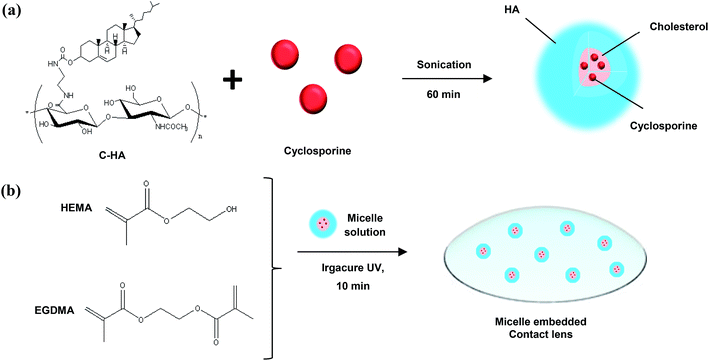 | ||
| Fig. 1 Schematic illustrations for (a) the preparation of cyclosporine-loaded C-HA micelles and (b) the fabrication of the micelle-embedded contact lens. | ||
2. Experimental section
2.1 Materials
Sodium hyaluronate (HA, MW 100 kDa) was purchased from Lifecore Biomedical (Chaska, MN). Tetrabutylammonium (TBA)-OH was obtained from Alfa Aesar (Ward Hill, MA). Dowex resin, ethylenediamine, cholesteryl chloroformate, hydroxyethyl methacrylate (HEMA), ethylene glycol dimethacrylate (EGDMA), cyclosporine, insulin, epithelial growth factor (EGF), hydrocortisone, and chleratoxin were obtained from Sigma-Aldrich (St. Louis, MO). Dulbecco's Modified Eagle's Medium/F-12 Nutrient Mixture Ham (DMEM/F-12) mixture (3/1), penicillin and streptomycin were obtained from WelGENE (Seoul, Korea).2.2 Preparation methods
![[thin space (1/6-em)]](https://www.rsc.org/images/entities/char_2009.gif) :
:![[thin space (1/6-em)]](https://www.rsc.org/images/entities/char_2009.gif) 1, v/v). The reaction solution was stirred at room temperature for 30 min, which was mixed with 4.2 mg of 4-(4,6-dimethoxy-1,3,5-triazin-2-yl)-4-methylmorpholinium chloride. After stirring at room temperature for 24 h, the resulting product was dialyzed against a large excess amount of 0.5 M NaCl solution, 50% ethanol, and water and then lyophilized for 3 days. The cholesterol content was determined by proton nuclear magnetic resonance (1H NMR) analysis (DPX500, Bruker, Germany) in deuterium oxide.
1, v/v). The reaction solution was stirred at room temperature for 30 min, which was mixed with 4.2 mg of 4-(4,6-dimethoxy-1,3,5-triazin-2-yl)-4-methylmorpholinium chloride. After stirring at room temperature for 24 h, the resulting product was dialyzed against a large excess amount of 0.5 M NaCl solution, 50% ethanol, and water and then lyophilized for 3 days. The cholesterol content was determined by proton nuclear magnetic resonance (1H NMR) analysis (DPX500, Bruker, Germany) in deuterium oxide.
2.3 Characterization methods
| EWC = (Wwet − Wdry)/Wdry × 100 |
2.4 In vivo therapeutic effect test
![[thin space (1/6-em)]](https://www.rsc.org/images/entities/char_2009.gif) kg, Orient Bio, Seoul, Korea) were approved by the Institutional Review Board of Catholic University and performed in accordance with the Association for Research in Vision and Ophthalmology Statement for the Use of Animals in Ophthalmic and Vision Research. The rabbits received 3-concanavalin A injections (Con A, Sigma L7647), one each into the inferior lacrimal gland (ILG), the palpebral portion of the superior lacrimal gland (PSLG), and the orbital portion of the superior lacrimal gland (OSLG). Using a 26-gauge needle, 10 mg of Con A in 1 mL was injected, which was repeated after 1 and 3 days.
kg, Orient Bio, Seoul, Korea) were approved by the Institutional Review Board of Catholic University and performed in accordance with the Association for Research in Vision and Ophthalmology Statement for the Use of Animals in Ophthalmic and Vision Research. The rabbits received 3-concanavalin A injections (Con A, Sigma L7647), one each into the inferior lacrimal gland (ILG), the palpebral portion of the superior lacrimal gland (PSLG), and the orbital portion of the superior lacrimal gland (OSLG). Using a 26-gauge needle, 10 mg of Con A in 1 mL was injected, which was repeated after 1 and 3 days.
3. Results and discussion
3.1 Characteristics of cholesterol-hyaluronate micelles
C-HA was synthesized by the conjugation of HA-TBA with CAEC. The cholesterol content of C-HA was determined by 1H NMR analysis (ESI Fig. S1†). The grafted ratio of cholesteryl groups was about 3.8 mol%, which was calculated from the integration ratio between the peaks of the N-acetyl group of HA (δ = 1.96, COCH3) and the methyl group of cholesterol (δ = 0.79, CH3). C-HA self-assembled into micelle-like nanoparticles in the aqueous solution due to the hydrophobic interaction between cholesterols.26 The hydrophobic drug cyclosporine used for dry eye syndrome was loaded in the C-HA micelles by the sonication and dialysis method. The formation of cyclosporine/C-HA micelles and the loading efficiency of cyclosporine within the C-HA micelles were analyzed by DLS and TEM. The diameter was measured to be 290.0 ± 35.95 nm (n = 3) and the zeta potential of the particle was measured to be −17.4 ± 3 (n = 3) by DLS (ESI Fig. S2a and b†). The TEM image in Fig. S3† shows spherical particles with a diameter of ca. 300 nm. As shown in Fig. S4,† there is negligible cytotoxicity in HCECs for the C-HA micelle concentration from 10 to 500 μg mL−1.3.2 Characterization of drug-eluting contact lens
3.3 In vivo biological activity of cyclosporine/C-HA micelles
In order to investigate the therapeutic effect of cyclosporine/C-HA micelle-embedded contact lenses on dry eye syndrome, we tested three kinds of samples: the normal control contact lens, cyclosporine by eye drops (0.05 mg mL−1), and cyclosporine/C-HA micelle-embedded contact lens on the right eye (oculus dexter, OD) of DED model rabbits for a week. The left eye (oculus sinister, OS) was bare and did not have a contact lens. The patency was assessed by the Schirmer tear test, corneal fluorescein staining, and DED marker MMP9 analysis.Fig. 6a shows the image of corneal fluorescein staining for each group. For fluorescein staining, sodium fluorescein was topically applied to the ocular surface of rabbits, typically without sedation. Several minutes after the treatment, corneal fluorescein staining was scored under a microscope using a blue light for the irregularities in the eye, such as abrasion and inflammation, which fluoresce with a great intensity relative to that of the healthy corneal tissue. In the case of ODs with the control normal contact lens and cyclosporine eye drops, the fluorescence signal remained after wearing normal contact lens or treatment by eye drops for 7 days. In contrast, OD with the cyclosporine/C-HA micelle-embedded contact lens showed significantly low fluorescence intensity, reflecting that the corneal surface inflammation was greatly reduced; this is possibly due to the therapeutic effect of the released cyclosporine. Fig. 6d shows the quantitative fluorescence analysis in pixel units.
The immunofluorescence staining analysis for a dry eye marker of MMP9 confirmed the therapeutic effect of the cyclosporine/C-HA micelle-embedded contact lens treatment. Fig. 7a and b show the MMP9 staining in the cornea. The intensity of MMP9 was slightly reduced in the eye treated by cyclosporine eye drops. In the case of rabbits wearing the cyclosporine/C-HA micelle-embedded contact lens, significant reduction of MMP9 was observed in the cornea (Fig. 7c). The results indicated that cyclosporine was released from the C-HA micelle-embedded contact lens and caused a significant therapeutic effect on dry eye syndrome.
Fig. 7d shows the tear production of eyes wearing the cyclosporine/C-HA micelle-embedded contact lens for 4 h a day in comparison to that without wearing the contact lens. In the case of cyclosporine eye drops, two drops were administered per day. The analysis of tear production after 7 days showed decrease in rabbits wearing the normal contact lens and slight increase in rabbits treated by cyclosporine eye drops. In contrast, the tear production was greatly enhanced for the rabbits wearing the cyclosporine/C-HA micelle-embedded contact lens, suggesting that the drug was steadily released from the contact lens, which was sufficient for the therapeutic effect.
4. Conclusions
C-HA was successfully synthesized by conjugating CAEC to HA-TBA in DMSO by amide bond formation between the amine groups in CAEC and the carboxyl groups in HA. Cyclosporine as a dry eye therapeutic drug was loaded in the micellar structure of the synthesized C-HA. The formation of cyclosporine-loaded micelles was confirmed by DLS, zeta potential, TEM, and HPLC analyses. The transmittance analysis, EWC test, WE test, water contact angle analysis, and tensile strength test confirmed the improved physical and mechanical properties of C-HA micelle-embedded contact lenses compared to those of the normal PHEMA contact lens as a control. In vitro release tests showed the continuous release of cyclosporine from the cyclosporine/C-HA micelle-embedded contact lens for more than 10 days. Finally, the therapeutic effect on dry eye syndrome was successfully confirmed by the Schirmer tear test, corneal fluorescein staining, and MMP9 fluorescein analysis in the DED model rabbits. Taken together, we can confirm the feasibility of cyclosporine/C-HA micelle-embedded contact lenses for further clinical development. These drug-eluting contact lenses would be greatly beneficial for dry eye syndrome patients wearing contact lenses.Conflicts of interest
There are no conflicts to declare.Acknowledgements
This research was supported by the Nano·Material Technology Development Program (No. 2017M3A7B8065278) and the Basic Science Research Program (2017R1E1A1A03070458) of the National Research Foundation (NRF) funded by the Ministry of Science and ICT, Korea. This work was also supported by Interojo Co. and the World Class 300 Project (R&D) (S2482887) funded by the Ministry of SMEs and Startups of Korea.References
- S. Ding, Recent developments in ophthalmic drug delivery, Pharm. Sci. Technol. Today, 1998, 1(8), 328–335 CrossRef CAS.
- T. Loftsson and E. Stefansson, Cyclodextrins in eye drop formulations: enhanced topical delivery of corticosteroids to the eye, Acta Ophthalmol. Scand., 2002, 80(2), 144–150 CrossRef CAS.
- C. G. Wilson and Y. P. Zhu, Ocular contact time of a carbonmer gel (GelTears) in humans, Br. J. Ophthalmol., 1998, 82(10), 1131–1134 CrossRef CAS.
- D. L. Meadows and J. R. Paugh, et al., A novel method to evaluate residence time in humans using a nonpenetrating fluorescent tracer, Invest. Ophthalmol. Visual Sci., 2002, 43(4), 1032–1039 Search PubMed.
- G. R. Snibson and J. L. Greaves, et al., Precorneal residence times of sodium hyaluronate solutions studied by quantitative gamma scintigraphy, Eye, 1990, 4, 594–602 CrossRef.
- A. Farkouh and P. Frigo, et al., Systemic side effects of eye drops: A pharmacokinetic perspective, Clin. Ophthalmol., 2016, 10, 2433–2441 CrossRef CAS.
- C. C. Peng and M. T. Burke, et al., Extended drug delivery by contact lenses for glaucoma therapy, J. Controlled Release, 2012, 162(1), 152–158 CrossRef CAS.
- F. H. Nasr and S. Khoee, et al., Preparation and evaluation of contact lenses embedded with polycaprolactone-based nanoparticles for ocular drug delivery, Biomacromolecules, 2016, 17(2), 485–495 CrossRef CAS.
- S. K. Sahoo and F. Dilnawaz, et al., Nanotechnology in ocular drug delivery, Drug Discovery Today, 2008, 13, 144–151 CrossRef CAS.
- U. B. Kompella and A. C. Amrite, et al., Nanomedicines for back of the eye drug delivery, gene delivery, and imaging, Prog. Retinal Eye Res., 2013, 36, 172–198 CrossRef CAS.
- V. Delplace and S. Payne, et al., Delivery strategies for treatment of age-related ocular diseases: From a biological understanding to biomaterial solutions, J. Controlled Release, 2015, 219, 652–668 CrossRef CAS.
- A. Bochot and E. Fattal, et al., Liposomes for intravitreal drug delivery: A state of the art, J. Controlled Release, 2012, 161(2), 628–634 CrossRef CAS.
- K. Kataoka and A. Harada, et al., Block copolymer micelles for drug delivery: Design, characterization and biological significance, Adv. Drug Delivery Rev., 2012, 64, 37–48 CrossRef.
- K. Kazunori and G. S. Kwon, et al., Block copolymer micelles as vehicles for drug delivery, J. Controlled Release, 1993, 24, 119–132 CrossRef.
- M. L. Adams and A. Lavasanifar, et al., Amphiphilic Block Copolymer for Drug Delivery, J. Pharm. Sci., 2003, 92(7), 1343–1355 CrossRef CAS.
- G. S. Kwon and M. Naito, et al., Block copolymer micelles as vehicles for hydrophobic drugs, Colloids Surf., B, 1994, 2(4), 429–434 CrossRef CAS.
- A. Lavasanifar and J. Samuel, et al., Poly(ethylene oxide)-block-poly(L-amino acid) micelles for drug delivery, Adv. Drug Delivery Rev., 2002, 54(2), 169–190 CrossRef CAS.
- S. R. Croy and G. S. Kwon, Polymeric micelles for drug delivery, Curr. Pharm. Des., 2006, 12(36), 4669–4684 CrossRef CAS PubMed.
- J. Necas and L. Bartosikova, et al., Hyaluronic acid (hyaluronan): a review, Vet. Med., 2008, 53(8), 397–411 CrossRef CAS.
- M. Ali and M. E. Byrne, Controlled release of high molecular weight hyalutonic acid from molecularly imprinted hydrogel contact lenses, Pharm. Res., 2009, 26(3), 714–726 CrossRef CAS.
- R. Gurny and H. Ibrahim, et al., Design and evaluation of controlled release systems for the eye, J. Controlled Release, 1987, 6(1), 367–373 CrossRef CAS.
- M. F. Saettone and P. Chetoni, et al., Evaluation of muco-adhesive properties and in vivo activity of ophthalmic vehicles based on hyaluronic acid, Int. J. Pharm., 1989, 51(3), 203–212 CrossRef CAS.
- E. J. Oh and K. Park, et al., Synthesis, characterization, and preliminary assessment of anti-Flt1 peptide-hyaluronate conjugate for the treatment of corneal neovascularization, Biomaterials, 2009, 30(30), 6026–6034 CrossRef CAS.
- E. J. Oh and J. W. Kim, et al., Signal Transduction of Hyaluronic Acid-Peptide Conjugate for Formyl Peptide Receptor Like 1 Receptor, Bioconjugate Chem., 2008, 19(12), 2401–2408 CrossRef CAS PubMed.
- W. Miao and G. Shim, et al., Cholesteryl hyaluronic acid-coated, reduced graphene oxide nanosheets for anti-cancer drug delivery, Biomaterials, 2013, 34(37), 9638–9647 CrossRef CAS.
- X. Wei and T. H. Senanayake, et al., Hyaluronic acid-based nanogel-drug conjugates with enhanced anticancer acticity designed for the targeting of CD44-positive and drug-resistant tumors, Bioconjugate Chem., 2013, 24(4), 658–668 CrossRef CAS.
Footnotes |
| † Electronic supplementary information (ESI) available. See DOI: 10.1039/c9ra02858g |
| ‡ These authors contributed equally to this work and should be considered as co-first authors. |
| This journal is © The Royal Society of Chemistry 2019 |

